2007 GMC SIERRA CLASSIC wheel
[x] Cancel search: wheelPage 440 of 674

K-2500 Crew Cab
Standard Box HD (4WD)*Axle Ratio Maximum Trailer Weight GCWR
6.6L V8 Diesel 3.73 14,200 lbs (6 441 kg) 22,000 lbs (9 979 kg)
*Fifth-wheel or gooseneck kingpin weight should be 15 percent to 25 percent of trailer weight up to 3,000 lbs
(1 361 kg) maximum.
*Trailer rating limited to 12,000 lbs (5 443 kg) with weight distributing hitch.
K-2500 Regular Cab
Long Box HD (4WD)*Axle Ratio
Maximum Trailer Weight GCWR
6000 V8 4.10 10,300 lbs (4 672 kg) 16,000 lbs (7 257 kg)
8100 V83.73
4.1013,800 lbs (6 260 kg)
15,800 lbs (7 167 kg)20,000 lbs (9 072 kg)
22,000 lbs (9 979 kg)
6.6L V8 Diesel 3.73 15,600 lbs (7 076 kg) 22,000 lbs (9 979 kg)
*Fifth-wheel or gooseneck kingpin weight should be 15 percent to 25 percent of trailer weight up to 3,000 lbs
(1 361 kg) maximum.
*Trailer rating limited to 12,000 lbs (5 443 kg) with weight distributing hitch.
K-2500 Extended Cab
Long Box HD (4WD)*Axle Ratio Maximum Trailer Weight GCWR
6000 V8 4.10 9,900 lbs (4 490 kg) 16,000 lbs (7 257 kg)
8100 V83.73
4.1013,400 lbs (6 078 kg)
15,400 lbs (6 985 kg)20,000 lbs (9 072 kg)
22,000 lbs (9 979 kg)
6.6L V8 Diesel 3.73 14,800 lbs (6 713 kg) 22,000 lbs (9 979 kg)
*Fifth-wheel or gooseneck kingpin weight should be 15 percent to 25 percent of trailer weight up to 3,000 lbs
(1 361 kg) maximum.
*Trailer rating limited to 12,000 lbs (5 443 kg) with weight distributing hitch.
440
Page 441 of 674

K-2500 Crew Cab Long
Box HD (4WD)*Axle Ratio Maximum Trailer Weight GCWR
6000 V8 4.10 9,700 lbs (4 400 kg) 16,000 lbs (7 257 kg)
8100 V83.73
4.1013,200 lbs (5 987 kg)
14,600 lbs (6 622 kg)20,000 lbs (9 072 kg)
22,000 lbs (9 979 kg)
6.6L V8 Diesel 3.73 13,200 lbs (5 987 kg) 22,000 lbs (9 979 kg)
*Fifth-wheel or gooseneck kingpin weight should be 15 percent to 25 percent of trailer weight up to 3,000 lbs
(1 361 kg) maximum.
*Trailer rating limited to 12,000 lbs (5 443 kg) with weight distributing hitch.
C-3500 Regular Cab
(2WD)*Axle Ratio Maximum Trailer Weight GCWR
6000 V8 4.10 10,300 lbs (4 672 kg) 16,000 lbs (7 257 kg)
*Fifth-wheel or gooseneck kingpin weight should be 15 percent to 25 percent of trailer weight up to 3,500 lbs
(1 587 kg) maximum.
*Trailer rating limited to 12,000 lbs (5 443 kg) with weight distributing hitch.
C-3500 Extended Cab
(2WD)*Axle Ratio Maximum Trailer Weight GCWR
6000 V8 4.10 9,800 lbs (4 445 kg) 16,000 lbs (7 257 kg)
6000 V8 (Dual Rear
Wheels)4.10 9,700 lbs (4 400 kg) 16,000 lbs (7 257 kg)
8100 V8 4.10 15,500 lbs (7 031 kg) 22,000 lbs (9 979 kg)
8100 V8 (Dual Rear
Wheels)4.10 15,300 lbs (6 940 kg) 22,000 lbs (9 979 kg)
6.6L V8 Diesel (Manual) 3.73 15,300 lbs (6 940 kg) 22,000 lbs (9 979 kg
441
Page 442 of 674
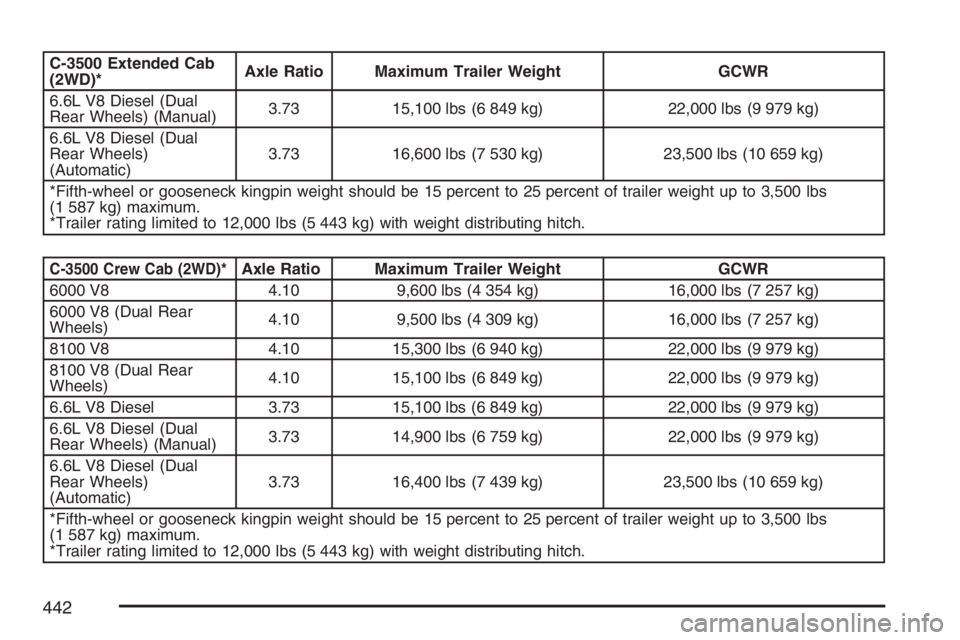
C-3500 Extended Cab
(2WD)*Axle Ratio Maximum Trailer Weight GCWR
6.6L V8 Diesel (Dual
Rear Wheels) (Manual)3.73 15,100 lbs (6 849 kg) 22,000 lbs (9 979 kg)
6.6L V8 Diesel (Dual
Rear Wheels)
(Automatic)3.73 16,600 lbs (7 530 kg) 23,500 lbs (10 659 kg)
*Fifth-wheel or gooseneck kingpin weight should be 15 percent to 25 percent of trailer weight up to 3,500 lbs
(1 587 kg) maximum.
*Trailer rating limited to 12,000 lbs (5 443 kg) with weight distributing hitch.
C-3500 Crew Cab (2WD)*Axle Ratio Maximum Trailer Weight GCWR
6000 V8 4.10 9,600 lbs (4 354 kg) 16,000 lbs (7 257 kg)
6000 V8 (Dual Rear
Wheels)4.10 9,500 lbs (4 309 kg) 16,000 lbs (7 257 kg)
8100 V8 4.10 15,300 lbs (6 940 kg) 22,000 lbs (9 979 kg)
8100 V8 (Dual Rear
Wheels)4.10 15,100 lbs (6 849 kg) 22,000 lbs (9 979 kg)
6.6L V8 Diesel 3.73 15,100 lbs (6 849 kg) 22,000 lbs (9 979 kg)
6.6L V8 Diesel (Dual
Rear Wheels) (Manual)3.73 14,900 lbs (6 759 kg) 22,000 lbs (9 979 kg)
6.6L V8 Diesel (Dual
Rear Wheels)
(Automatic)3.73 16,400 lbs (7 439 kg) 23,500 lbs (10 659 kg)
*Fifth-wheel or gooseneck kingpin weight should be 15 percent to 25 percent of trailer weight up to 3,500 lbs
(1 587 kg) maximum.
*Trailer rating limited to 12,000 lbs (5 443 kg) with weight distributing hitch.
442
Page 443 of 674
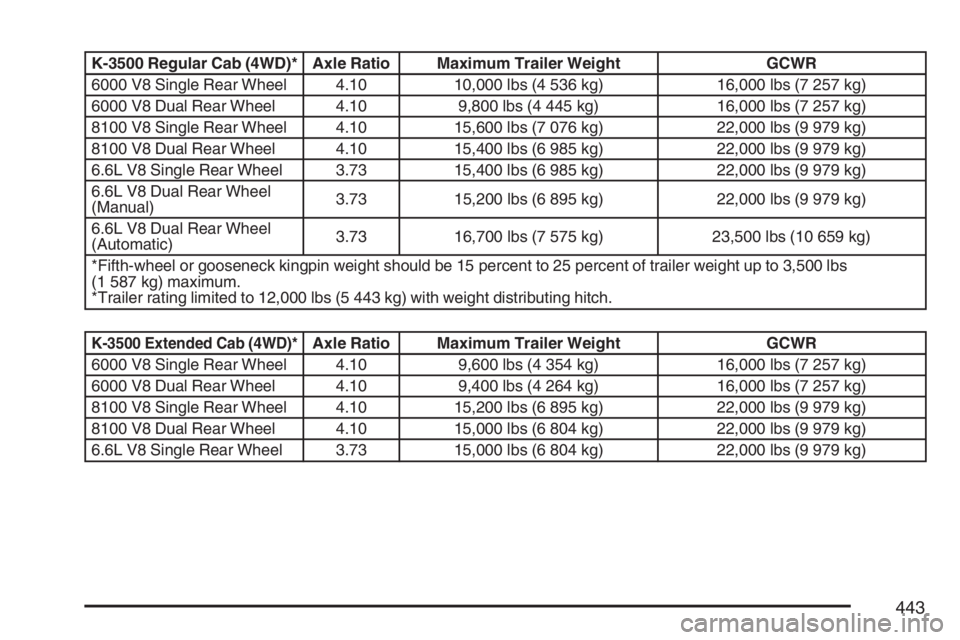
K-3500 Regular Cab (4WD)* Axle Ratio Maximum Trailer Weight GCWR
6000 V8 Single Rear Wheel 4.10 10,000 lbs (4 536 kg) 16,000 lbs (7 257 kg)
6000 V8 Dual Rear Wheel 4.10 9,800 lbs (4 445 kg) 16,000 lbs (7 257 kg)
8100 V8 Single Rear Wheel 4.10 15,600 lbs (7 076 kg) 22,000 lbs (9 979 kg)
8100 V8 Dual Rear Wheel 4.10 15,400 lbs (6 985 kg) 22,000 lbs (9 979 kg)
6.6L V8 Single Rear Wheel 3.73 15,400 lbs (6 985 kg) 22,000 lbs (9 979 kg)
6.6L V8 Dual Rear Wheel
(Manual)3.73 15,200 lbs (6 895 kg) 22,000 lbs (9 979 kg)
6.6L V8 Dual Rear Wheel
(Automatic)3.73 16,700 lbs (7 575 kg) 23,500 lbs (10 659 kg)
*Fifth-wheel or gooseneck kingpin weight should be 15 percent to 25 percent of trailer weight up to 3,500 lbs
(1 587 kg) maximum.
*Trailer rating limited to 12,000 lbs (5 443 kg) with weight distributing hitch.
K-3500 Extended Cab (4WD)*Axle Ratio Maximum Trailer Weight GCWR
6000 V8 Single Rear Wheel 4.10 9,600 lbs (4 354 kg) 16,000 lbs (7 257 kg)
6000 V8 Dual Rear Wheel 4.10 9,400 lbs (4 264 kg) 16,000 lbs (7 257 kg)
8100 V8 Single Rear Wheel 4.10 15,200 lbs (6 895 kg) 22,000 lbs (9 979 kg)
8100 V8 Dual Rear Wheel 4.10 15,000 lbs (6 804 kg) 22,000 lbs (9 979 kg)
6.6L V8 Single Rear Wheel 3.73 15,000 lbs (6 804 kg) 22,000 lbs (9 979 kg)
443
Page 444 of 674
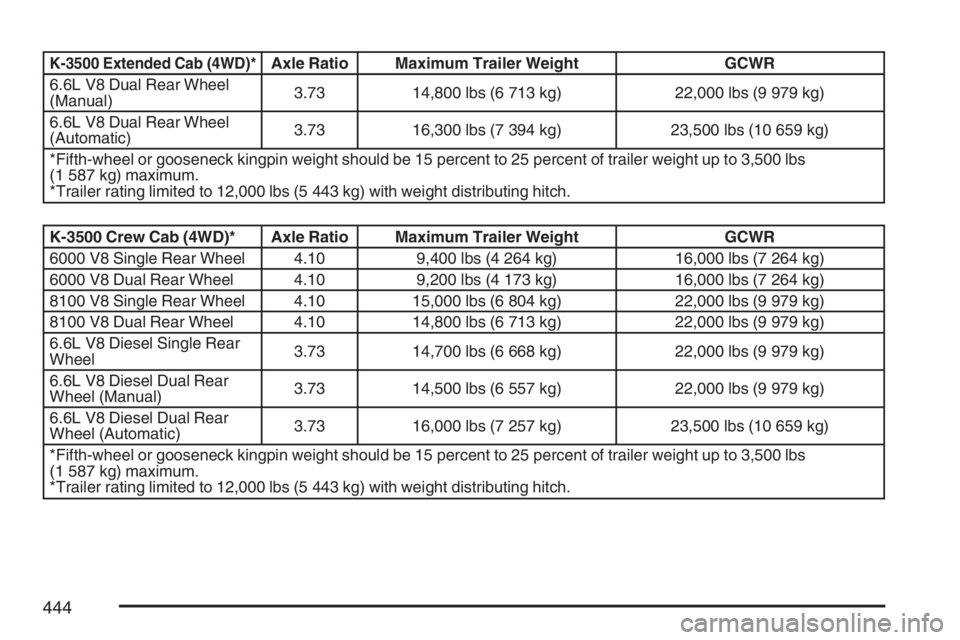
K-3500 Extended Cab (4WD)*Axle Ratio Maximum Trailer Weight GCWR
6.6L V8 Dual Rear Wheel
(Manual)3.73 14,800 lbs (6 713 kg) 22,000 lbs (9 979 kg)
6.6L V8 Dual Rear Wheel
(Automatic)3.73 16,300 lbs (7 394 kg) 23,500 lbs (10 659 kg)
*Fifth-wheel or gooseneck kingpin weight should be 15 percent to 25 percent of trailer weight up to 3,500 lbs
(1 587 kg) maximum.
*Trailer rating limited to 12,000 lbs (5 443 kg) with weight distributing hitch.
K-3500 Crew Cab (4WD)* Axle Ratio Maximum Trailer Weight GCWR
6000 V8 Single Rear Wheel 4.10 9,400 lbs (4 264 kg) 16,000 lbs (7 264 kg)
6000 V8 Dual Rear Wheel 4.10 9,200 lbs (4 173 kg) 16,000 lbs (7 264 kg)
8100 V8 Single Rear Wheel 4.10 15,000 lbs (6 804 kg) 22,000 lbs (9 979 kg)
8100 V8 Dual Rear Wheel 4.10 14,800 lbs (6 713 kg) 22,000 lbs (9 979 kg)
6.6L V8 Diesel Single Rear
Wheel3.73 14,700 lbs (6 668 kg) 22,000 lbs (9 979 kg)
6.6L V8 Diesel Dual Rear
Wheel (Manual)3.73 14,500 lbs (6 557 kg) 22,000 lbs (9 979 kg)
6.6L V8 Diesel Dual Rear
Wheel (Automatic)3.73 16,000 lbs (7 257 kg) 23,500 lbs (10 659 kg)
*Fifth-wheel or gooseneck kingpin weight should be 15 percent to 25 percent of trailer weight up to 3,500 lbs
(1 587 kg) maximum.
*Trailer rating limited to 12,000 lbs (5 443 kg) with weight distributing hitch.
444
Page 446 of 674
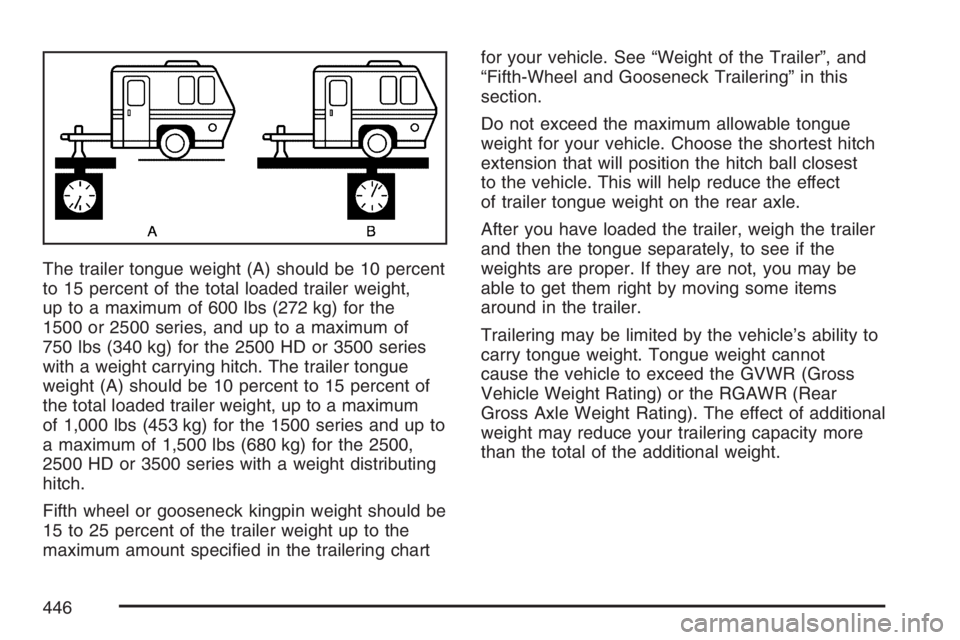
The trailer tongue weight (A) should be 10 percent
to 15 percent of the total loaded trailer weight,
up to a maximum of 600 lbs (272 kg) for the
1500 or 2500 series, and up to a maximum of
750 lbs (340 kg) for the 2500 HD or 3500 series
with a weight carrying hitch. The trailer tongue
weight (A) should be 10 percent to 15 percent of
the total loaded trailer weight, up to a maximum
of 1,000 lbs (453 kg) for the 1500 series and up to
a maximum of 1,500 lbs (680 kg) for the 2500,
2500 HD or 3500 series with a weight distributing
hitch.
Fifth wheel or gooseneck kingpin weight should be
15 to 25 percent of the trailer weight up to the
maximum amount speci�ed in the trailering chartfor your vehicle. See “Weight of the Trailer”, and
“Fifth-Wheel and Gooseneck Trailering” in this
section.
Do not exceed the maximum allowable tongue
weight for your vehicle. Choose the shortest hitch
extension that will position the hitch ball closest
to the vehicle. This will help reduce the effect
of trailer tongue weight on the rear axle.
After you have loaded the trailer, weigh the trailer
and then the tongue separately, to see if the
weights are proper. If they are not, you may be
able to get them right by moving some items
around in the trailer.
Trailering may be limited by the vehicle’s ability to
carry tongue weight. Tongue weight cannot
cause the vehicle to exceed the GVWR (Gross
Vehicle Weight Rating) or the RGAWR (Rear
Gross Axle Weight Rating). The effect of additional
weight may reduce your trailering capacity more
than the total of the additional weight.
446
Page 449 of 674

Weight-Distributing Hitches and Weight
Carrying Hitches
A:Body to Ground Distance
B:Front of Vehicle
When using a weight-distributing hitch, the hitch
must be adjusted so the distance (A) remains
the same both before and after coupling the trailer
to the tow vehicle.If you use a step-bumper hitch, the bumper could
be damaged in sharp turns. Make sure there is
ample room when turning to avoid contact between
the trailer and the bumper.
If you will be pulling a trailer that, when loaded,
will weigh more than 5,000 lbs (2 270 kg) be sure
to use a properly mounted weight-distributing
hitch and sway control of the proper size.
This equipment is very important for proper vehicle
loading and good handling when driving. Always
use a sway control if the trailer will weigh
more than these limits. You can ask a hitch dealer
about sway controls.
Fifth Wheel and Gooseneck Trailering
Fifth wheel and gooseneck trailers can be
used with many pickup models. These trailers
place a larger percentage of the weight (kingpin
weight) on the tow vehicle than conventional
trailers. Make sure this weight does not cause the
vehicle to exceed GAWR or GVWR.
Fifth wheel or gooseneck kingpin weight should be
15 to 25 percent of the trailer weight up to the
maximum amount speci�ed in the trailering chart
for your vehicle. See “Weight of the Trailer” in
this section for more information.
449
Page 450 of 674
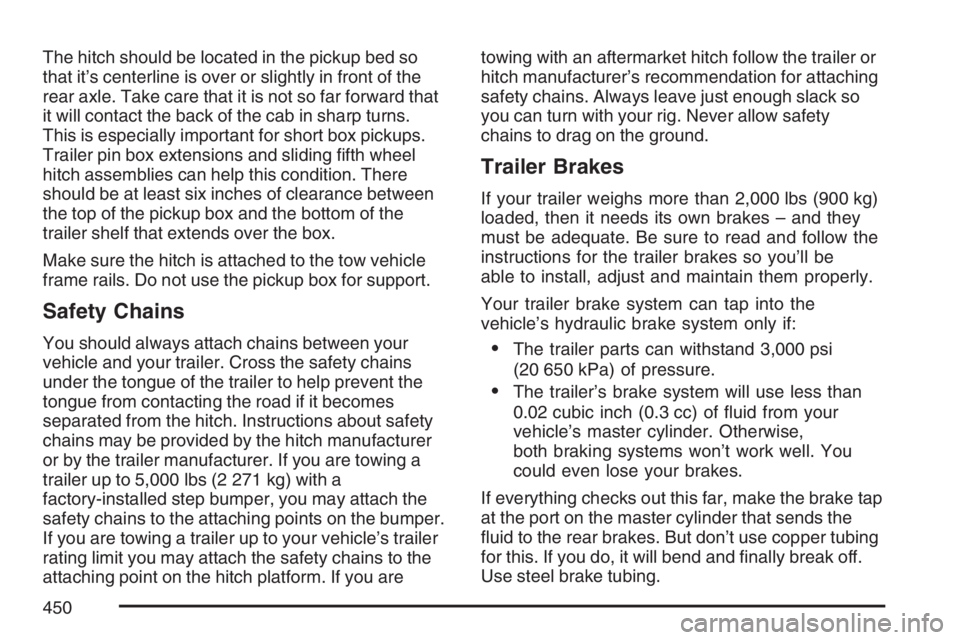
The hitch should be located in the pickup bed so
that it’s centerline is over or slightly in front of the
rear axle. Take care that it is not so far forward that
it will contact the back of the cab in sharp turns.
This is especially important for short box pickups.
Trailer pin box extensions and sliding �fth wheel
hitch assemblies can help this condition. There
should be at least six inches of clearance between
the top of the pickup box and the bottom of the
trailer shelf that extends over the box.
Make sure the hitch is attached to the tow vehicle
frame rails. Do not use the pickup box for support.
Safety Chains
You should always attach chains between your
vehicle and your trailer. Cross the safety chains
under the tongue of the trailer to help prevent the
tongue from contacting the road if it becomes
separated from the hitch. Instructions about safety
chains may be provided by the hitch manufacturer
or by the trailer manufacturer. If you are towing a
trailer up to 5,000 lbs (2 271 kg) with a
factory-installed step bumper, you may attach the
safety chains to the attaching points on the bumper.
If you are towing a trailer up to your vehicle’s trailer
rating limit you may attach the safety chains to the
attaching point on the hitch platform. If you aretowing with an aftermarket hitch follow the trailer or
hitch manufacturer’s recommendation for attaching
safety chains. Always leave just enough slack so
you can turn with your rig. Never allow safety
chains to drag on the ground.
Trailer Brakes
If your trailer weighs more than 2,000 lbs (900 kg)
loaded, then it needs its own brakes – and they
must be adequate. Be sure to read and follow the
instructions for the trailer brakes so you’ll be
able to install, adjust and maintain them properly.
Your trailer brake system can tap into the
vehicle’s hydraulic brake system only if:
The trailer parts can withstand 3,000 psi
(20 650 kPa) of pressure.
The trailer’s brake system will use less than
0.02 cubic inch (0.3 cc) of �uid from your
vehicle’s master cylinder. Otherwise,
both braking systems won’t work well. You
could even lose your brakes.
If everything checks out this far, make the brake tap
at the port on the master cylinder that sends the
�uid to the rear brakes. But don’t use copper tubing
for this. If you do, it will bend and �nally break off.
Use steel brake tubing.
450